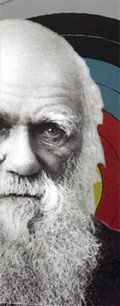Reading the Five Ways
4. The intelligibility of the world
 Imagine that you were walking across a foggy field, and suddenly found an iron chain dangling in front of you. The fog prevents you from seeing very high, but it is clear that the bottom link of the chain is dangling a foot or more above the ground. You can see that the bottom link is suspended from the second, the second from the third, and so on up to about the fiftieth – which is as far as you can see. You know, however, that the fiftieth link up must itself be suspended from something – and the chain seems securely suspended when you tug sharply downwards on it. Curious (and foolhardy), you climb a little way up the chain, and find that the fiftieth link is indeed suspended from the fifty-first, the fifty-first from the fifty-second, and so on and so on, as far up as you feel capable of climbing. You let yourself carefully back down to the ground.
Imagine that you were walking across a foggy field, and suddenly found an iron chain dangling in front of you. The fog prevents you from seeing very high, but it is clear that the bottom link of the chain is dangling a foot or more above the ground. You can see that the bottom link is suspended from the second, the second from the third, and so on up to about the fiftieth – which is as far as you can see. You know, however, that the fiftieth link up must itself be suspended from something – and the chain seems securely suspended when you tug sharply downwards on it. Curious (and foolhardy), you climb a little way up the chain, and find that the fiftieth link is indeed suspended from the fifty-first, the fifty-first from the fifty-second, and so on and so on, as far up as you feel capable of climbing. You let yourself carefully back down to the ground.
If you were anything like Aquinas, even though you can’t see far into the fog, you would think it clear that had you been able to go on climbing, you would at some point have had to reach something which was not simply another link in the chain: some method or means of suspension of a different kind. You would think that the discovery of yet another link, or of any number of links, would not really count as an answer to your initial question: ‘Just what is holding this thing up?’
So, if you were anything like Aquinas, you would think it clear that at some point (you cannot say how far up) you must be going to encounter something that, unlike any given link in the chain, does not require you to ask what it is suspended from. You might speculate: perhaps it will be the outstretched arm of a crane which itself is resting upon the same floor from which you have climbed; perhaps it will be a wire strung between two nearby buildings. Or perhaps something more unusual: is the chain as a whole held up by some bizarre magnetic field? Or is it – I don’t know – held up by gravity at the Lagrange point between the earth and the moon? Who knows. Any kind of explanation which allows us to stop asking what the next link in the chain is suspended from will do.
The alternative would be that at some point you would simply come to the top of the chain, and find that your grasping hands closed on empty air, not because you have missed something (some other explanation, some other form of suspension) but because that is all there is, arbitrarily and incomprehensibly.
Or perhaps you would find that you could simply climb on up forever, which is another kind of arbitrary incomprehensibility. One link is no explanation, two links is no explanation, a million links are no explanation: to carry on discovering more links provides no explanation, even though one carry on forever.
So, either the world is radically incomprehensible – or, if the world is at all intelligible, then at some point there must be some kind of answer to the ‘What is this suspended from?’ question that does not simply consist in the identification of a set of higher links – an answer of a different kind. The assumption that there must be some such an answer – even if the fog should be so thick, or the chain so long, that we will in fact never discover it – is the assumption that the world is intelligible: that, at some level, the world makes sense.
In putting forward at least the first three of his Five Ways, it is this intelligibility of the world that provides the ground upon which Aquinas takes his stand.
There are two connected senses in which his ‘proofs’ trade on that intelligibility. In the first place, faced with the baffling complexity of things – their strange interlockings, the odd patterns of action and interaction that knot them together – he believes that we have a strategy to pursue to make sense of them. We can ask Why? – and we can go on asking it, doggedly and persistently, worrying away at the world like a terrier until it yields answers. We can be like a three-year-old, refusing every to stop with any partial or questionable answer offered to us, instead always and again asking, ‘But why?’ We may not yet be able to answer some of those questions. There may be some why questions that we will, in fact, never answer – questions whose answers are in some way beyond our capacity. But we can always go on asking, with a basic trust that even if we don’t know it yet there must be some kind of answer.
In the second place, however, Aquinas believes that things only truly become intelligible, and we only truly provide explanations, if the chain of answers that our questioning tugs on is suspended from some kind of end point. It may be beyond our present understanding; it may remain beyond our understanding – but if the world is at all intelligible, there must be some such end point. We trade upon that assumption, Aquinas thinks, every time we go around insistently tugging on chains.
Remember, however, what I said in the last section about the emptiness of the Five Ways. Aquinas says nothing in this section of the argument that tells you what this end-point must be, except what is bound up with the very idea of an end-point: it must be (in terms of my chain analogy) a something from which things are suspended that is not itself suspended from anything, a something that does not need to be suspended from anything: the chain can only stop at an unmoved mover, a first cause, a something whose existence depends on nothing but itself. In other words, the only content that he provides at this point – the only thing that he thinks the Five Ways prove – is that there is some kind of end-point which isn’t itself just another link in the chain.
(Yes, I realise that it looks like Aquinas does say more than that – but I’ll come back to that in a later section.)
Note two final things at this point. First, Aquinas’s assumption is not about our power to understand the world fully, to trace the chain all the way back to the source. Fundamentally, his assumption is about the world, not about our minds. Everything connects: the world is articulated – and that is why we can go on asking ‘Why?’.
Second, the full intelligibility of the world requires a transition from one kind of question to another. In Aquinas’ terms, the world’s intelligibility is a matter of both physics (the science of the chain links) and of the science of what comes beyond physics: metaphysics.
 You are standing in a field and are startled when, one by one, ten arrows shoot past you. Seven of them hit a nearby target; two undershoot; only one misses wildly, parting your hair and burying itself in a nearby tree. Whilst you can explain the movement of the arrow through the air by reference to the laws of simple projectile motion, you guess that something other than, say, a random explosion has hurled these arrows into the air: there is nothing that could ‘draw’ them towards the target so consistently unless they had somehow been aimed. There must be some being with a capacity to take the target into account – a capacity to aim – somewhere in the process.
You are standing in a field and are startled when, one by one, ten arrows shoot past you. Seven of them hit a nearby target; two undershoot; only one misses wildly, parting your hair and burying itself in a nearby tree. Whilst you can explain the movement of the arrow through the air by reference to the laws of simple projectile motion, you guess that something other than, say, a random explosion has hurled these arrows into the air: there is nothing that could ‘draw’ them towards the target so consistently unless they had somehow been aimed. There must be some being with a capacity to take the target into account – a capacity to aim – somewhere in the process.
 We are not those readers, and this claim sounds very strange in our ears. You can get a sense for it, though, by thinking about heat. You can, perhaps, imagine a worldview in which all heat in the world was believed ultimately to be derived from the sun, either as a direct result of the sun’s heat warming something up, or because the sun’s heat had somehow been stored in things to be released when they were burnt (or by some other process). If you saw things in this way, you might well regard claims about things on earth being more or less hot as involving the placement of those things somewhere on a scale that ran all the way up to the sun: ‘heat’ would, for you, mean ‘likeness to the sun’.
We are not those readers, and this claim sounds very strange in our ears. You can get a sense for it, though, by thinking about heat. You can, perhaps, imagine a worldview in which all heat in the world was believed ultimately to be derived from the sun, either as a direct result of the sun’s heat warming something up, or because the sun’s heat had somehow been stored in things to be released when they were burnt (or by some other process). If you saw things in this way, you might well regard claims about things on earth being more or less hot as involving the placement of those things somewhere on a scale that ran all the way up to the sun: ‘heat’ would, for you, mean ‘likeness to the sun’. In the 1980 film
In the 1980 film  If you want to get a clear mental picture of what the first Way says about the world, it is worth noting that the chains that Aquinas joins together are not necessarily in themselves temporal (even though each link in the chains is itself a temporal change). Aquinas is not presenting a picture of each new change depending upon some other change that took place some time before. Rather, he pictures the world as something more like a clock: the hands move because the spindle they are attached to moves; that spindle moves because this cog moves; this cog moves because that one does; that one does because the escapement mechanism moves; the mechanism moves because the pendulum moves: the clock as a whole is an ordered set of interlocking movements and dependencies.
If you want to get a clear mental picture of what the first Way says about the world, it is worth noting that the chains that Aquinas joins together are not necessarily in themselves temporal (even though each link in the chains is itself a temporal change). Aquinas is not presenting a picture of each new change depending upon some other change that took place some time before. Rather, he pictures the world as something more like a clock: the hands move because the spindle they are attached to moves; that spindle moves because this cog moves; this cog moves because that one does; that one does because the escapement mechanism moves; the mechanism moves because the pendulum moves: the clock as a whole is an ordered set of interlocking movements and dependencies.  Aquinas is able to see his world as an intelligible one because he looks through a lens polished by certain concepts. Those concepts help him articulate the world’s intelligibility.
Aquinas is able to see his world as an intelligible one because he looks through a lens polished by certain concepts. Those concepts help him articulate the world’s intelligibility. Imagine that you were walking across a foggy field, and suddenly found an iron chain dangling in front of you. The fog prevents you from seeing very high, but it is clear that the bottom link of the chain is dangling a foot or more above the ground. You can see that the bottom link is suspended from the second, the second from the third, and so on up to about the fiftieth – which is as far as you can see. You know, however, that the fiftieth link up must itself be suspended from something – and the chain seems securely suspended when you tug sharply downwards on it. Curious (and foolhardy), you climb a little way up the chain, and find that the fiftieth link is indeed suspended from the fifty-first, the fifty-first from the fifty-second, and so on and so on, as far up as you feel capable of climbing. You let yourself carefully back down to the ground.
Imagine that you were walking across a foggy field, and suddenly found an iron chain dangling in front of you. The fog prevents you from seeing very high, but it is clear that the bottom link of the chain is dangling a foot or more above the ground. You can see that the bottom link is suspended from the second, the second from the third, and so on up to about the fiftieth – which is as far as you can see. You know, however, that the fiftieth link up must itself be suspended from something – and the chain seems securely suspended when you tug sharply downwards on it. Curious (and foolhardy), you climb a little way up the chain, and find that the fiftieth link is indeed suspended from the fifty-first, the fifty-first from the fifty-second, and so on and so on, as far up as you feel capable of climbing. You let yourself carefully back down to the ground.
Recent Comments